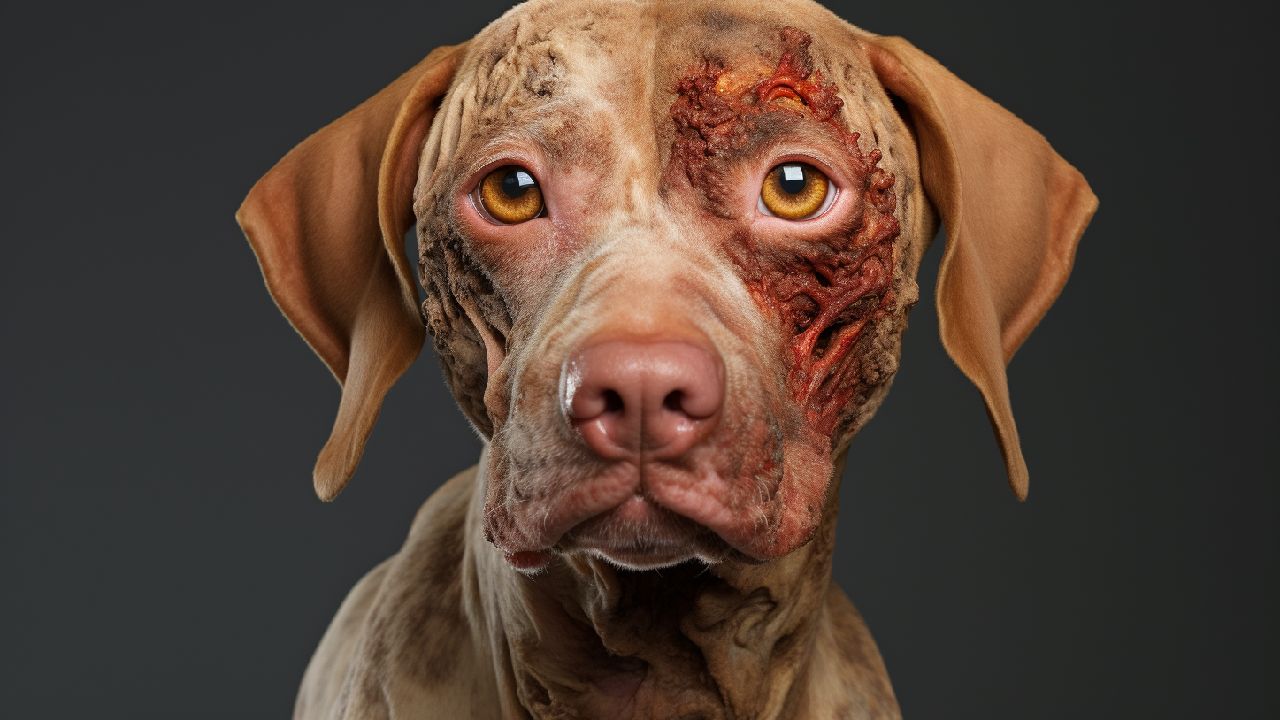Understanding the shadow of cancer that affects one in three dogs becomes crucial in a world where dogs are not just pets but family. This stark reality, underscored by the fact that cancer is a leading cause of death in senior dogs, highlights the importance of early detection.
Awareness is our first line of defense. Let this article remind us of the importance of vigilance in our pets’ health, emphasizing early detection and the promising treatments available in the fight against dog cancer.
Unexplained Weight Loss
Imagine this scenario: your dog, who once had a hearty appetite and a full, glossy coat, suddenly starts shedding pounds despite eating well. This could be a red flag for cancer.
Unexplained weight loss is one of the most common signs of canine cancer, often accompanied by muscle wasting.
While it’s important to remember that weight fluctuations can have various causes, consulting your veterinarian when your dog loses weight unexpectedly is prudent.
Changes in Your Dog’s Appetite
An increase and a decrease in appetite warrant attention and could signal different health concerns.
Sudden Increase in Appetite:
- A noticeable shift from regular eating habits to an insatiable hunger could point to specific health issues.
- Lymphoma or gastrointestinal tumors may cause an increased appetite due to the body’s altered metabolism.
Loss of Appetite:
- While it’s common for dogs to occasionally skip a meal, a prolonged disinterest in food is concerning.
- A loss of appetite can be associated with various types of cancer or other serious health conditions that affect the dog’s overall well-being and ability to eat.
Cancerous Lumps and Bumps
Our dogs’ bodies should be familiar territory to us. Regularly checking for unusual lumps or bumps can help detect cancer in its early stages. These lumps can appear anywhere on the body, from under the skin to inside the mouth. While not all lumps are cancerous, any new growth that persists over a week or two warrants a veterinary evaluation. Early detection can lead to successful removal and treatment.

Recognizing Signs of Cancer in Dogs
Observing your dog’s behavior and physical health is crucial for detecting potential health issues, including cancer. Changes in bathroom habits, noticeable lethargy, and respiratory distress are among the signs that should prompt a consultation with your veterinarian.
- Changes in Bathroom Habits: Any deviation in your dog’s regular bathroom routine, such as increased frequency of urination, difficulty urinating, presence of blood in urine, or diarrhea, could indicate cancer affecting the urinary or gastrointestinal tracts.
- Lethargy and Weakness: A marked decrease in energy levels or a noticeable disinterest in activities your dog previously enjoyed can be a warning sign. Cancer can significantly affect a dog’s vitality, leading to an overall sense of lethargy and weakness.
- Respiratory Distress: Symptoms like coughing, wheezing, and labored breathing should never be overlooked, as these can indicate cancer affecting the respiratory system. Such signs warrant immediate veterinary attention to determine the cause and commence appropriate treatment.
Monitoring your dog for these symptoms can aid in early cancer detection, potentially improving the outcome through early intervention. Always consult your vet if you notice any changes in your dog’s health or behavior.
Identifying Cancer in Dogs
Being vigilant about changes in odors, mobility, and skin appearance can lead to early detection and treatment.
Foul Odors: While dogs aren’t known for having the freshest breath, a persistent foul odor from the mouth, nose, or anal area could indicate serious health issues like oral, nasal, or anal cancer. Although dental problems can also cause unpleasant smells, it’s critical to have these symptoms evaluated by a vet to rule out cancer.
Persistent Lameness: If your dog shows signs of lameness or limping that doesn’t improve after rest, it could be a bone or joint cancer symptom. Monitoring your dog’s gait and responding to signs of pain by seeking veterinary advice is essential for early diagnosis and treatment.
Skin Changes: The skin is another area where cancer can become apparent. Look for non-healing sores, ulcers, or any new pigmentation changes. These symptoms require professional evaluation to determine their cause and appropriate treatment.
While relatively common in dogs, skin cancer can often go unnoticed until it reaches an advanced stage. Regularly inspect your dog’s skin during grooming sessions to catch any abnormalities early on.

Behavioral Changes of Dogs with Cancer
Our dogs have a way of communicating with us, even when words fail them. Behavioral changes such as increased aggression, anxiety, or depression can sometimes be linked to underlying medical issues, including cancer. If your dog displays unusual behaviors, consult your veterinarian to rule out any physical causes.
Understanding the signs of cancer in dogs is crucial to that responsibility. Many other conditions can mimic these symptoms, so consulting your veterinarian is essential.
A healthy diet and a loving environment can all contribute to your dog’s longer and happier life. The bond we share with our dogs is exceptional, and we must ensure they live their lives to the fullest, free from the shadows of this silent adversary.
Our four-legged friends depend on us to look out for their well-being. Listen to your dog’s body, and do a regular veterinary check-up. Remember, early detection can be the key to a successful battle against cancer, giving your beloved pet a chance at a brighter, healthier future.

FAQs
Are some breeds more prone to cancer?
Golden Retrievers are more susceptible to lymphoma, while Bernese Mountain Dogs are prone to histiocytic sarcoma. Understanding breed-specific cancer risks can help owners be more vigilant in monitoring their dog’s health and seeking timely veterinary care.
Can changes in behavior indicate cancer in dogs?
Yes, changes in behavior can sometimes signal cancer in dogs. Watch for alterations in your dog’s normal behavior patterns, such as increased irritability, reluctance to exercise or play, or withdrawal from social interaction.
Is it common for older dogs to develop cancer?
Unfortunately, cancer is more prevalent in older dogs. As dogs age, their cells may undergo mutations that can lead to the development of cancerous growths. It’s crucial for pet owners of senior dogs to remain vigilant for signs of cancer and to schedule regular check-ups with their veterinarian to catch any potential issues early on.
Can a healthy diet help prevent cancer in dogs?
While there’s no guaranteed way to prevent cancer in dogs, maintaining a healthy diet can contribute to overall well-being and potentially reduce the risk of certain cancers. A balanced diet rich in nutrients, antioxidants, and essential fatty acids can support your dog’s immune system and cellular health.
How critical is regular veterinary care?
Regular veterinary care is paramount in detecting cancer early and improving dog treatment outcomes. Veterinarians are trained to recognize subtle signs of illness, perform thorough examinations, and recommend appropriate diagnostic tests, such as bloodwork or imaging scans, to detect cancer in its early stages. Early detection allows for prompt intervention and can significantly increase the chances of successful treatment.
What should I do if I suspect my dog might have cancer?
If you suspect your dog might have cancer or notice any concerning symptoms, don’t hesitate to schedule an appointment with your veterinarian. Your vet can conduct a comprehensive physical examination, perform diagnostic tests as needed, and develop a treatment plan.






This article hit home for me. Lost my sweet lab to cancer last year. Wish I knew these signs earlier. Awareness is key, folks.